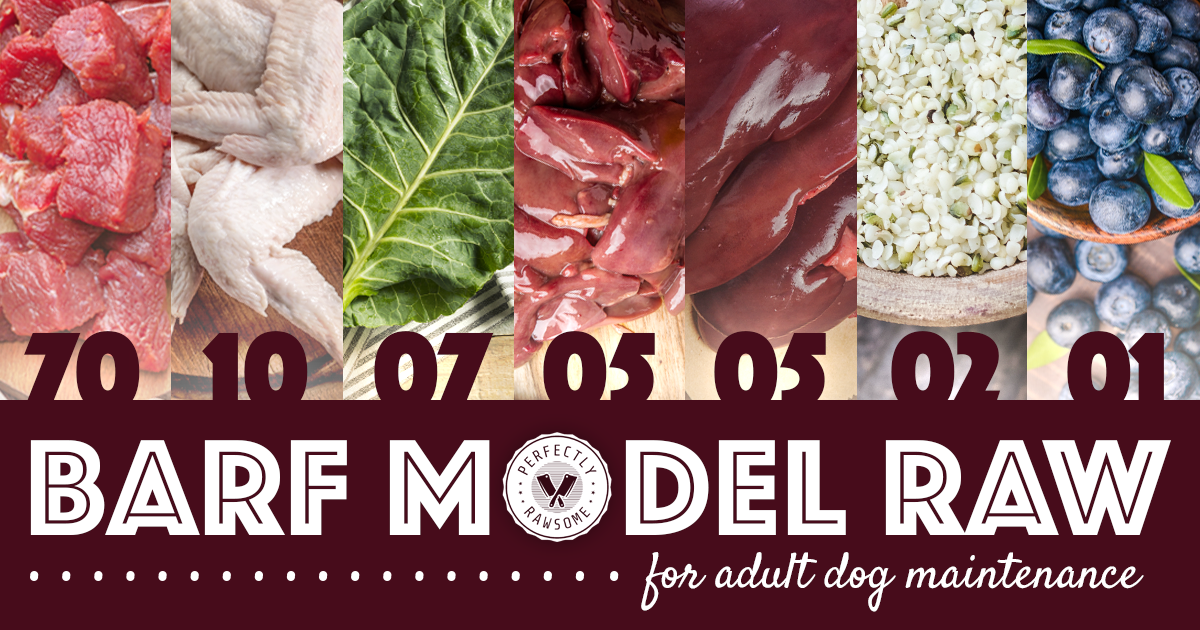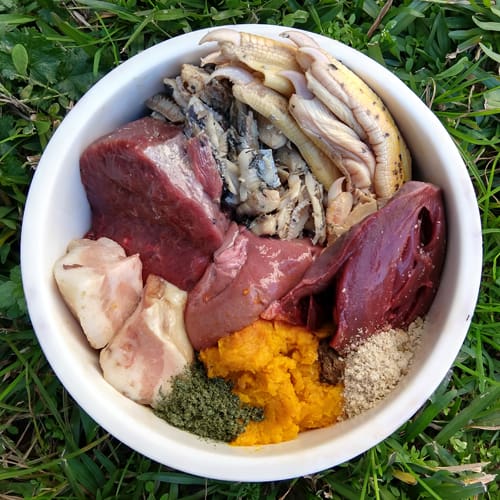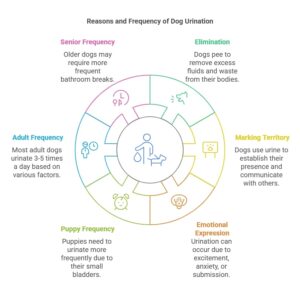Raw food can be beneficial for dogs when balanced correctly. It may improve coat health, energy levels, and digestion.
The debate over raw food diets for dogs continues to gain traction among pet owners. Advocates argue that a raw diet mimics a dog's natural eating habits, potentially leading to better health outcomes. Supporters claim improvements in coat condition, energy levels, and digestive health.
However, raw diets must be carefully managed to ensure they meet nutritional needs. Risks like bacterial contamination and nutritional imbalances exist, making it vital to consult a veterinarian before making any dietary changes. Understanding the pros and cons helps pet owners make informed decisions for their furry companions. A balanced approach can lead to a healthier, happier dog.
Table of Contents
ToggleRaw Food For Dogs: A Trend On The Rise
The trend of feeding dogs a raw food diet is gaining popularity. Many pet owners believe this diet is healthier for their furry friends. They argue that raw food mimics what dogs ate in the wild. This shift towards a more natural diet is changing how we view pet nutrition.
Popularity Surge Among Pet Owners
More pet owners are choosing raw diets for their dogs. Here are some reasons for this surge:
- Increased awareness of dog nutrition
- Desire for healthier alternatives to processed foods
- Reports of improved dog health on raw diets
- Growing community support through forums and social media
Pet owners share success stories. They highlight benefits like better skin, shinier coats, and higher energy levels. This word-of-mouth has fueled interest in raw feeding.
The Raw Diet Basics
The raw food diet typically includes:
| Food Type | Examples |
|---|---|
| Meat | Beef, chicken, lamb |
| Organs | Liver, kidney, heart |
| Raw bones | Chicken necks, beef ribs |
| Fruits and vegetables | Carrots, apples, spinach |
A balanced raw diet aims to provide essential nutrients. It can boost immune systems and improve digestion. Many owners prepare meals at home. Others buy pre-packaged raw food.
Research shows raw diets can be safe. Proper handling and sourcing are key. Consult a veterinarian before making changes. This ensures dogs get all needed nutrients.

Credit: perfectlyrawsome.com
Historical Diet Of Canines
The diet of dogs has changed over thousands of years. Understanding their historical eating habits helps us know what they need today. Many pet owners wonder if a raw food diet is suitable for dogs. This section explores their ancestral diets and how they evolved over time.
Ancestral Eating Habits
Canines originated from wolves. Their natural diet consisted mainly of:
- Meat
- Organs
- Bones
- Vegetation
Wolves hunted in packs. They targeted large prey such as deer and elk. They consumed everything, including:
- Muscle meat
- Internal organs
- Bone marrow
This diet provided essential nutrients for survival. Wolves also foraged for fruits and vegetables. This added variety to their meals.
Evolution Of Domestic Dog Diets
As dogs became domesticated, their diets changed. Humans began to provide food. The diet shifted from wild prey to:
- Cooked meats
- Cereal grains
- Vegetables
This change occurred about 15,000 years ago. Many breeds developed specific dietary needs. Some dogs thrived on grains, while others required more protein. Today, commercial dog foods often contain:
| Ingredients | Purpose |
|---|---|
| Meat | Protein source |
| Grains | Energy source |
| Vegetables | Vitamins and minerals |
Modern diets often include additives. These enhance flavor and shelf-life. Despite this, some dog owners prefer raw food diets. They believe it mimics ancestral eating habits.
Potential Benefits Of A Raw Diet
Feeding dogs a raw diet has gained popularity. Many pet owners notice some potential benefits. Here are a few key advantages of a raw food diet.
Improved Coat Condition
One of the most visible benefits of a raw diet is a dog's coat. A raw diet can lead to a shinier and healthier coat. This happens because of better nutrition.
- High-quality proteins contribute to coat health.
- Essential fatty acids keep the skin moisturized.
- Vitamins and minerals support overall skin condition.
Many owners report a noticeable difference in their dog's fur. A healthy coat indicates a well-nourished pet.
Enhanced Energy Levels
A raw diet often boosts a dog's energy levels. Dogs may become more playful and active. This increase in energy can improve their overall well-being.
- Raw diets provide more bioavailable nutrients.
- Dogs digest raw food more easily.
- Increased energy leads to more exercise opportunities.
Active dogs are happier and healthier. Enhanced energy levels can improve their quality of life.
Health Risks And Considerations
Raw food diets for dogs can pose certain health risks. Understanding these risks is crucial for dog owners. Two main concerns include bacterial contamination and nutritional imbalances.
Bacterial Contamination Concerns
Raw food can contain harmful bacteria. Common bacteria include:
- Salmonella
- Escherichia coli (E. coli)
- Listeria
These bacteria can lead to serious health issues in dogs. Symptoms may include:
- Vomiting
- Diarrhea
- Fever
Dogs with weak immune systems are at higher risk. Always handle raw food safely. Wash hands and surfaces after preparing meals.
Nutritional Imbalance Issues
Raw diets can lead to nutritional imbalances. Essential nutrients might be missing, including:
| Nutrient | Possible Deficiency |
|---|---|
| Calcium | Bone growth issues |
| Vitamin E | Skin problems |
| Omega-3 fatty acids | Joint issues |
Consult a veterinarian before switching to raw food. They can help ensure a balanced diet for your dog.
Debunking Common Myths
Many myths surround the raw food diet for dogs. Understanding these myths helps pet owners make informed choices. Let's explore two common concerns: aggression and bone safety.
Raw Food And Aggression
One widespread myth claims that raw food makes dogs aggressive. This belief often stems from misconceptions about dog behavior.
- Dietary Impact: Raw food does not inherently cause aggression.
- Behavioral Factors: Aggression often links to training and socialization.
- Individual Differences: Each dog has a unique personality.
Many owners report improved behavior after switching to raw food. Balanced nutrition can help maintain a dog’s overall well-being.
Bone Consumption Safety
Another myth suggests that all bones are dangerous for dogs. The truth is that some bones can be safe and beneficial.
| Type of Bone | Safety Level | Notes |
|---|---|---|
| Raw Bones | Safe | Do not splinter. |
| Cooked Bones | Unsafe | Can splinter and cause injury. |
| Soft Bones | Safe | Good for dental health. |
Always supervise your dog while they chew bones. Choose appropriate sizes to prevent choking hazards. Consult your vet for personalized advice on bone consumption.
Veterinary Perspectives On Raw Diets
Veterinarians have diverse views on raw diets for dogs. Some support them, while others express concerns. Understanding these perspectives helps pet owners make informed choices.
Professional Recommendations
Many veterinarians recommend balanced diets. Here are key points from their recommendations:
- Commercial dog food meets nutritional needs.
- Raw diets may lack essential nutrients.
- Food safety is crucial to prevent illness.
- Consult a vet before changing your dog's diet.
Case Studies And Clinical Evidence
Research shows mixed results on raw diets. Some studies highlight benefits, while others show risks.
| Study Type | Findings |
|---|---|
| Clinical Trials | Improved coat condition in some dogs. |
| Case Studies | Instances of bacterial infections reported. |
| Nutrition Assessments | Raw diets often lack vitamins and minerals. |
Veterinarians stress the need for caution. Choosing a raw diet requires careful planning.
Monitoring your dog's health is essential. Regular vet check-ups can help catch any issues early.
Transitioning Your Dog To Raw Food
Switching your dog to a raw food diet can be exciting. It offers fresh ingredients and natural nutrition. Careful planning makes the transition smoother. Let’s explore how to do it step-by-step.
Step-by-step Introduction
Transitioning to raw food needs patience and attention. Follow these simple steps:
- Consult Your Vet: Talk to your veterinarian before changing diets.
- Choose the Right Raw Food: Select a balanced raw food option.
- Start Slow: Begin with small portions of raw food mixed with current food.
- Gradually Increase Raw Food: Slowly increase raw food over 7 to 10 days.
- Observe Your Dog: Watch your dog's reaction to the new food.
Monitoring Your Dog's Health
Keeping an eye on your dog's health is crucial. Look for these signs:
- Energy Levels: Increased energy means your dog is adjusting well.
- Coat Condition: A shiny coat shows good nutrition.
- Stool Quality: Firm and smaller stools indicate proper digestion.
- Overall Mood: A happy dog is a healthy dog.
If you notice any issues, consult your vet. Changes in diet can lead to adjustments in health.
.webp?width=792&height=1633&name=best-fruits-veggies-raw-food%20(1).webp)
Credit: blog.homesalive.ca
Homemade Vs. Commercial Raw Diets
Choosing between homemade and commercial raw diets for dogs can be challenging. Each option has unique benefits and drawbacks. Understanding these can help you make the best choice for your furry friend.
Pros And Cons Of Diy
Making raw food at home allows you to control ingredients. You can ensure quality and freshness. However, it requires time and effort.
| Pros | Cons |
|---|---|
| Control over ingredients | Time-consuming to prepare |
| Customizable recipes | Risk of nutrient imbalance |
| Fresh and wholesome food | Requires knowledge of dog nutrition |
Evaluating Commercial Options
Commercial raw diets offer convenience. They save time and effort. However, not all products are created equal.
- Research brands with a good reputation.
- Look for AAFCO certification to ensure nutritional balance.
- Check ingredient lists for quality sources.
- Read reviews from other pet owners.
Consider your dog's specific needs. Some dogs may require special diets. Always consult a vet before switching diets.
Legal And Regulatory Stance On Raw Diets
The legal and regulatory stance on raw diets for dogs is complex. It involves guidelines from various authorities. Understanding these regulations is crucial for pet owners considering raw food. This section covers the FDA guidelines and industry standards.
Fda Guidelines And Raw Diets
The FDA plays a significant role in regulating pet food. Their guidelines focus on safety and nutrition. They categorize raw diets as “high-risk” due to potential bacterial contamination.
- Raw meat can carry pathogens like Salmonella and E. coli.
- Raw diets must meet certain safety standards.
- Pet owners should handle raw food carefully.
Despite the risks, the FDA does not ban raw diets. They recommend consulting a veterinarian. Owners must be informed about the benefits and dangers.
Industry Standards For Raw Pet Foods
Industry standards for raw pet foods vary widely. Many companies follow guidelines set by the Association of American Feed Control Officials (AAFCO).
| Standard | Description |
|---|---|
| Formulation | Must meet AAFCO nutritional guidelines. |
| Labeling | Must clearly state ingredients and nutritional values. |
| Processing | Must ensure safe handling and preparation of raw ingredients. |
Many brands claim to provide safe raw diets. Pet owners should check for quality assurance seals. Look for brands that follow strict safety protocols.
- Research companies before purchasing.
- Read reviews from other pet owners.
- Consult your veterinarian for recommendations.
Personal Stories And Testimonials
Pet owners often share their experiences with raw feeding. These stories highlight the benefits and challenges of this diet. Many find that raw food improves their dogs' health and happiness.
Success Stories Of Raw Feeding
Many pet owners report amazing transformations in their dogs. Here are some common success stories:
- Increased energy: Dogs become more active and playful.
- Shiny coats: Owners notice a significant improvement in fur quality.
- Better digestion: Fewer stomach issues and healthier stools.
- Weight management: Dogs maintain a healthy weight with raw food.
Here’s a table showcasing a few testimonials:
| Owner Name | Dog's Name | Results |
|---|---|---|
| Sarah Thompson | Max | More energy and a shinier coat |
| John Davis | Bella | Improved digestion and less shedding |
| Emily Johnson | Rex | Healthy weight and happier mood |
Challenges Faced By Pet Owners
Raw feeding isn’t without its challenges. Many owners encounter specific issues:
- Preparation time: Raw meals require planning and effort.
- Cost: High-quality ingredients can be expensive.
- Risk of bacteria: Raw meat can carry harmful bacteria.
- Balancing nutrition: Ensuring a complete diet is essential.
Some owners share their struggles:
- Finding reliable sources for raw ingredients.
- Understanding the right balance of nutrients.
- Dealing with picky eaters who refuse raw food.
- Concerns about transitioning from kibble to raw.
Creating A Balanced Raw Diet Plan
Crafting a balanced raw diet for dogs requires careful consideration. Each ingredient must provide essential nutrients. A well-planned diet supports overall health and vitality. It can also prevent health issues down the road.
Essential Nutrients For Dogs
Dogs need specific nutrients to thrive. These nutrients include:
- Proteins: Vital for growth and muscle repair.
- Fats: Provide energy and support skin health.
- Carbohydrates: Offer energy and aid digestion.
- Vitamins: Help with various bodily functions.
- Minerals: Essential for bone health and metabolic processes.
Consider including a variety of proteins. This could be chicken, beef, or fish. Each protein source has unique benefits. Rotate proteins to prevent allergies.
| Nutrient | Source | Benefits |
|---|---|---|
| Protein | Chicken, Beef | Muscle repair, energy |
| Fats | Fish Oil, Chicken Fat | Skin health, energy |
| Carbohydrates | Sweet Potatoes, Rice | Energy, digestion |
| Vitamins | Vegetables, Fruits | Immune support |
| Minerals | Bone Meal, Sea Salt | Bone health |
Consulting With A Nutritionist
Consulting with a pet nutritionist is crucial. They help design a personalized diet. A nutritionist ensures all nutrient needs are met. They also provide guidance on portion sizes.
During consultations, share your dog's:
- Age
- Weight
- Activity level
- Any health concerns
With a balanced raw diet plan, dogs can enjoy better health. They may have more energy and a shinier coat. Proper nutrition leads to a happier, healthier life.

Credit: perfectlyrawsome.com
Frequently Asked Questions
Is Raw Food Beneficial For Dogs?
Raw food can be beneficial for dogs when properly balanced. It may provide essential nutrients and improve digestion. However, it’s crucial to consult a veterinarian before making any dietary changes. Each dog is unique, and raw food may not suit every pet’s needs.
What Are The Risks Of Raw Dog Food Diets?
Feeding raw dog food can pose risks such as bacterial contamination. Raw meat may harbor harmful pathogens like Salmonella and E. coli. Additionally, an unbalanced diet can lead to nutritional deficiencies. Always ensure safety and seek professional guidance when considering a raw food diet for your dog.
Can Raw Food Improve My Dog's Health?
Many dog owners report improvements in coat quality and energy levels with raw food diets. Raw food can enhance digestion and promote healthy teeth. However, results can vary by individual dog. It's essential to monitor your dog's health and consult a vet for tailored advice.
How To Start A Raw Food Diet For Dogs?
Start slowly by introducing small amounts of raw food to your dog's diet. Gradually replace their current food over several days. Ensure that the raw diet is well-balanced with proteins, fats, and vitamins. Consulting a veterinarian can help you create a suitable plan for your pet’s needs.
Conclusion
Raw food diets for dogs can offer benefits, but they also come with risks. It's essential to balance nutrition and safety. Consulting a veterinarian is a smart move before making any changes to your dog's diet. Ultimately, the best diet is one that suits your dog's unique needs and keeps them healthy.














